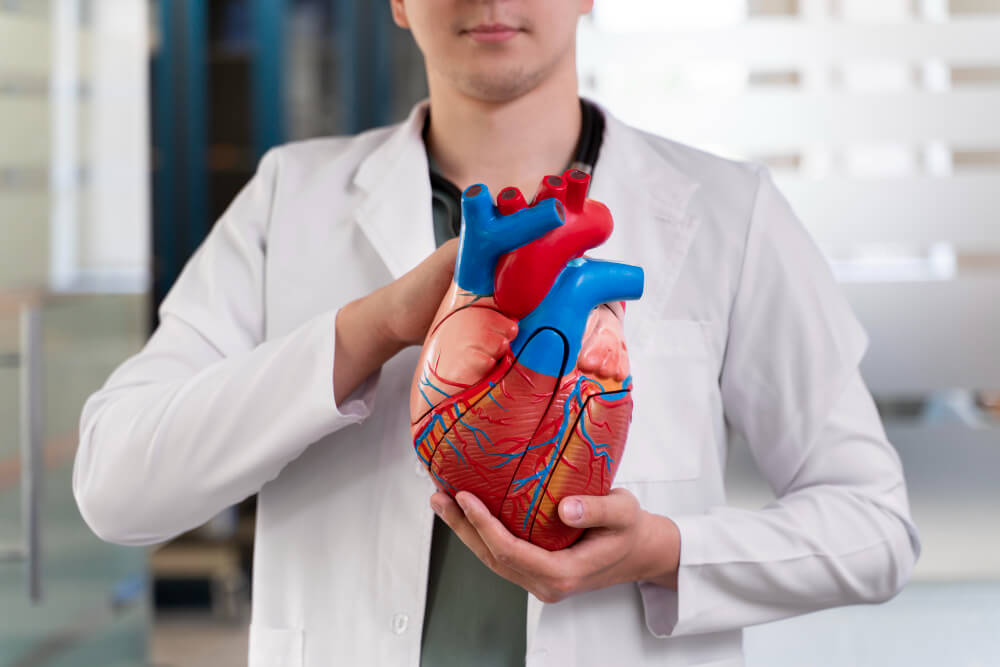Understanding and Conquering Cardiovascular Disease: A Comprehensive Guide to Prevention, Types, and Treatment
Cardiovascular disease (CVD) reigns as the leading cause of death globally, impacting millions of lives each year. This broad term encompasses a range of conditions affecting the heart and blood vessels. While the thought of heart disease might conjure images of a sudden heart attack, CVD manifests in various forms, each with its unique set of concerns.
This comprehensive guide aims to empower you with knowledge about cardiovascular disease. We’ll delve into the different types of heart disease, explore their symptoms and risk factors, and shed light on the various treatment options available. By understanding your heart’s health and the potential threats it faces, you can take proactive steps towards prevention and management.
Unveiling the Different Types of Heart Disease
The human cardiovascular system is a marvel of intricate design. It comprises the heart, a muscular pump that propels blood throughout the body, and a network of blood vessels that carry oxygen-rich blood to organs and tissues while returning deoxygenated blood for replenishment. When any part of this system malfunctions, it can lead to various forms of cardiovascular disease. Here’s a breakdown of some common types:
Coronary Artery Disease (CAD)
- The most prevalent form of heart disease, CAD arises due to a buildup of fatty deposits (atherosclerosis) within the coronary arteries. These arteries supply blood rich in oxygen to the heart muscle. As plaque accumulates, it narrows the arteries, restricting blood flow and potentially leading to chest pain (angina), shortness of breath, and even heart attacks.
Heart Attack
- A heart attack occurs when a sudden blockage disrupts blood flow to a part of the heart muscle. This blockage is often caused by a blood clot forming within a narrowed coronary artery due to CAD. Symptoms of a heart attack can include crushing chest pain radiating to the arm, jaw, or back, along with shortness of breath, nausea, and sweating. Immediate medical attention is crucial to minimize heart damage.
Heart Failure
- Contrary to its name, heart failure doesn’t imply the heart has stopped functioning entirely. Instead, it signifies the heart’s inability to pump blood effectively throughout the body. This can be caused by damage from a heart attack, high blood pressure, or other factors. Symptoms of heart failure include fatigue, shortness of breath, especially when lying down, and swelling in the ankles and feet.
Arrhythmias
- A normal heartbeat follows a steady rhythm. However, arrhythmias disrupt this rhythm, causing the heart to beat too fast (tachycardia), too slow (bradycardia), or irregularly. While some arrhythmias are benign, others can be life-threatening and require medical intervention. Symptoms of arrhythmias can include palpitations, chest pain, dizziness, and shortness of breath.
Congenital Heart Defects
- These are structural abnormalities of the heart and blood vessels present at birth. Defects can range from mild to severe, causing varying degrees of symptoms. Some common congenital heart defects include septal defects (holes in the heart walls) and valve malformations. Symptoms can include difficulty breathing, fatigue, and bluish skin discoloration (cyanosis). Early diagnosis and treatment are crucial for managing congenital heart defects.
Peripheral Artery Disease (PAD)
- PAD affects the arteries supplying blood to the legs and feet. Similar to CAD, atherosclerosis causes narrowing of these arteries, restricting blood flow. Symptoms of PAD can include leg pain that worsens with activity and improves with rest, numbness, tingling, and sores that are slow to heal.
Stroke
- While not strictly a heart disease, stroke is closely linked to CVD. A stroke occurs due to a blockage or rupture of a blood vessel supplying blood to the brain. This can lead to brain cell death and permanent neurological damage. Symptoms of stroke can include sudden weakness or numbness on one side of the body, difficulty speaking or understanding speech, and vision problems.
Recognizing the Warning Signs: Symptoms of Cardiovascular Disease
Early detection is paramount in managing cardiovascular disease effectively. Being familiar with the potential warning signs can help you identify concerns and seek medical attention promptly. Here’s a glimpse into some common CVD symptoms:
- Chest pain, pressure, or tightness, especially during exertion or stress.
- Shortness of breath, particularly when lying down or with minimal activity.
- Palpitations, a fluttering sensation in the chest, or an irregular heartbeat.
- Pain, numbness, or weakness in one or both legs (PAD)
- Dizziness, lightheadedness, or fainting.
- Excessive fatigue or tiredness.
- Sudden sweating.
- Unexplained swelling
Unveiling the Culprits: Risk Factors for Cardiovascular Disease
While genetics play a role in cardiovascular disease susceptibility, many risk factors are modifiable through lifestyle changes and preventive measures. Identifying and addressing these factors becomes crucial in safeguarding your heart health. Here are some key contributors to CVD risk:
- Unhealthy Diet: A diet high in saturated and trans fats, cholesterol, sodium, and added sugars can contribute to atherosclerosis and high blood pressure, both risk factors for CVD.
- Physical Inactivity: Regular physical activity promotes healthy blood pressure, cholesterol levels, and weight management, all crucial for heart health.
- Smoking: Smoking damages blood vessels and increases the risk of blood clots, significantly elevating the risk of heart attack and stroke.
- Obesity and Overweight: Excess weight puts a strain on the heart and increases blood pressure. Additionally, it can contribute to unhealthy cholesterol levels and diabetes, further amplifying CVD risk.
- High Blood Pressure (Hypertension): Uncontrolled high blood pressure forces the heart to work harder, eventually leading to heart damage and increasing the risk of stroke.
- High Cholesterol Levels: Elevated levels of LDL (“bad”) cholesterol contribute to plaque buildup in arteries, leading to CAD and other CVD forms.
- Diabetes: This chronic condition disrupts blood sugar control, leading to vascular damage and increasing the risk of CVD complications.
- Stress: Chronic stress can contribute to high blood pressure and unhealthy lifestyle choices, indirectly increasing CVD risk.
- Family History: Having a close family member with heart disease increases your susceptibility.
Taking Charge of Your Heart Health: Preventive Strategies
The good news is that many cardiovascular diseases are preventable or manageable. By adopting a heart-healthy lifestyle and working with your doctor, you can significantly reduce your risk of CVD. Here are some essential steps to take control of your heart health:
- Embrace a Heart-Healthy Diet: Focus on fruits, vegetables, whole grains, lean protein sources, and healthy fats like those found in fish, nuts, and avocados. Limit saturated and trans fats, cholesterol-rich foods, and added sugars.
- Get Regular Exercise: Aim for at least 150 minutes of moderate-intensity exercise or 75 minutes of vigorous-intensity aerobic activity per week. Strength training exercises twice a week also contribute to heart health.
- Maintain a Healthy Weight: If you’re overweight or obese, losing even a moderate amount of weight can significantly improve your heart health.
- Manage Stress: Techniques like yoga, meditation, and deep breathing can help manage stress and its negative impact on your heart.
- Quit Smoking: Quitting smoking is one of the most impactful ways to reduce your risk of heart disease. Talk to your doctor about resources and support options available.
- Control Blood Pressure: Regularly monitor your blood pressure and work with your doctor to manage it through medication and lifestyle changes if needed.
- Manage Cholesterol Levels: Maintain healthy cholesterol levels through dietary changes and medication if necessary.
- Manage Diabetes: If you have diabetes, managing your blood sugar levels effectively is crucial in reducing your risk of CVD complications.
- Schedule Regular Checkups: Regular visits to your doctor allow for early detection of risk factors and potential CVD concerns.
Navigating the Maze: Treatment Options for Cardiovascular Disease
The specific treatment for cardiovascular disease depends on the type, severity, and underlying cause. However, some common treatment approaches include:
- Lifestyle Modifications: As mentioned earlier, adopting a heart-healthy lifestyle is the cornerstone of managing most types of cardiovascular disease. It serves as a foundation for other treatment options.
- Medications: A range of medications are used to treat various aspects of CVD. These include medications to lower blood pressure, cholesterol, control arrhythmias, prevent blood clots, and manage heart failure.
- Minimally Invasive Procedures: Several minimally invasive procedures can address blocked arteries or malfunctioning heart valves. These include angioplasty with stent placement, atherectomy, and balloon valvuloplasty.
- Surgery: In some cases, more invasive surgeries may be necessary. Coronary artery bypass grafting (CABG) creates a detour around blocked arteries using blood vessels from elsewhere in the body. Heart valve replacement surgery involves replacing a damaged heart valve with an artificial or biological valve.
- Cardiac Rehabilitation: This program helps individuals recover from heart events and improve their overall cardiovascular health through exercise training, education, and counseling.


